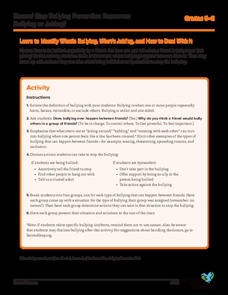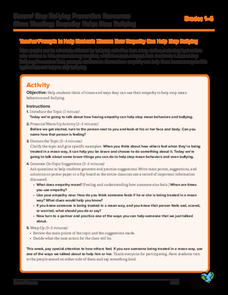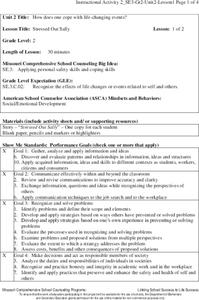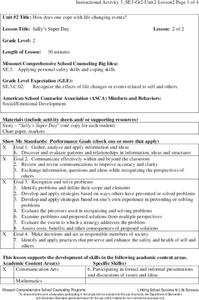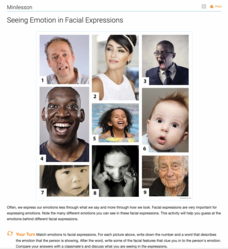Centervention
Halloween Worksheet: Monster Feelings
Monsters have feelings, too! Scholars explore a variety of emotions with a festive, Halloween flair with two dice-rolling activities. The first activity prompts learners to draw and write about a monster feeling a specific emotion. The...
Centervention
Halloween Worksheets: Emotions Jack-O-Lanterns
Scholars give life to a pumpkin as they design a Jack O'Lantern that exudes a certain emotion. Participants choose one of nine feeling words, or add up to three that aren't listed, locate and cut out face pieces, then glue them to the...
Centervention
Halloween Worksheets: Emotional Monsters
Eight blank monster faces make up an activity that tasks scholars with drawing a face that corresponds to a specific emotion. Feelings include happiness, confusion, silliness, and more.
Centervention
What Makes Me Happy Today?
Here's a worksheet that will put sunshine on papers and smiles on the faces of young learners as they draw pictures and write a short explanation of what makes them happy today. A great way to show gratitude for the good things in life.
University of Oklahoma
Learning About Special Education
The lessons in the second unit in a three-unit series provide students with the historical background of disability education. After reading about events that impacted attitudes towards disabilities and how learners are identified for...
Committee for Children
Learn to Identify What’s Bullying, What’s Joking, and How to Deal With It
A quick lesson takes a look at the differences between bullying and joking. Through whole-class discussion, scholars identify between the two behaviors and brainstorm actions to take to cease bullying behavior. Small groups share with...
Missouri Department of Elementary
My Feelings
Encourage self-awareness with a lesson that challenges scholars to identify feelings—happy, sad, mad, and scared. Using a feelings thermometer, similar to that of a bar graph, pupils discuss how they would feel in specific scenarios then...
Missouri Department of Elementary
What are Comfortable (Good) and Uncomfortable (Bad) Feelings?
Two puppets open a discussion about comfrotable and uncomfortable touches. Scholars add to the discussion information they remember from a previous lesson, then delve deep into three problem-solving safety rules, and explore...
Committee for Children
Class Meeting: Empathy Helps Stop Bullying
A lesson instills the importance of how empathy has the ability to aid in stopping bullying behavior. Scholars discuss, in-depth, a series of three questions. Using class input, an anchor chart is made then displayed for reference.
University of California
Breathing Boards
Instill the importance of mindfulness with six breathing exercises. Scholars trace shapes using their fingers, following arrows that tell them when to breathe in and when to breathe out. Exercises increase by counts of breath in and out.
Missouri Department of Elementary
Conflict Mediation – Part 1: Getting Ready
Two scholars walk into a room arguing, what is happening? Peers observe the two actors in preparation for a whole-class discussion about conflict. Learners establish a conflict, name the three approaches—passive, aggressive, and...
Missouri Department of Elementary
Stressed Out Sally
Life changes may cause stress. Here, scholars identify stressful situations in a peer's life and offer coping skills to make for a better day. A short story, "Stressed Out Sally," provides pupils with a look inside a bad day. After...
Missouri Department of Elementary
Sally’s Super Day
After having a bad day, Sally took scholars' suggestions and had a super day. Pupils listen to her newest short story then discuss the events that occurred. They sort each event by what was in her control and what was not. Participants...
Indigo Daya
Living With Difficult Emotions Self-Help Booklet
Anger, Sadness, Shame, Fear. A self-help booklet offers insight into how to manage these emotions. Included is information about helpful and unhelpful responses to these emotions, as well as worksheets that ask responders to reflect on...
Missouri Department of Elementary
What Is Comfortable and Uncomfortable Touch?
Two stuffed animals open a activity that examines two types of touch. Scholars discuss the difference between comfortable and uncomfortable touch. They offer examples then brainstorm ways an individual can keep safe from uncomfortable...
Missouri Department of Elementary
Feeling Faces
A lesson help scholars identify emotions through facial expressions. After a friendly puppet reads scholars a poem all about feelings, learners act out how they would feel when a specific action happens to them. Participants watch and...
Western Justice Center
Underlying Needs
Conflicts arise when underlying needs are unmet. An engaging video introduces viewers to nine basic human needs. Then, through a series of videos, worksheets, and activities, class members learn that by focusing on interests and needs,...
Thoughtful Learning
Expressing Emotions Through Drawing
Draw it out! Sometimes creating a picture is an easier way for pupils to express how they are feeling. A short mini-lesson encourages just that approach. After drawing an expressive picture, artists are asked to reflect on their work and...
Thoughtful Learning
Seeing Emotion in Facial Expressions
Learning to read body language, especially facial expressions, is the focus of a mini-lesson. Young learners examine a series of photographs, identify the emotion being illustrated, and then discuss the cues that revealed the emotion.
Nemours KidsHealth
Feelings: Grades K-2
Students explore how to appropriately deal with their feelings. In this personal health activity on feelings, students participate in a group discussion about feelings, and complete two activities writing about their feelings and...
Health Smart Virginia
Self-Awareness
Introvert or extrovert? To find out more about themselves, class members fill out an Introvert or Extrovert worksheet. Learners are also introduced to a decision-making model that enhances self-awareness.
Nemours KidsHealth
Empathy: Grades K-2
Second graders read articles about being afraid, dealing with anger and apologizing. For this feelings lesson, 2nd graders read articles and discuss the feelings they have. Students describe their feelings and how to be supportive of...







